Карикатуры на прически конца 18 века. Часть 2.
Карикатуры на прически конца 18 века. Как делали такие прически-фото.
Удалось найти еще карикатуры, некоторые у меня были в предыдущем посте, но сейчас нашлись большие, в хорошем качестве и с подробным описанием. Многие прически существовали в действительности- пейзажи, фермы, сады , горы и так далее. Портретов не сохранилось, но карикатуры пусть утрированно, но позволяют увидеть эти произведения парикмахерского искусства.
Также нашлось немного фотографий, где показан процесс создания таких причесок.
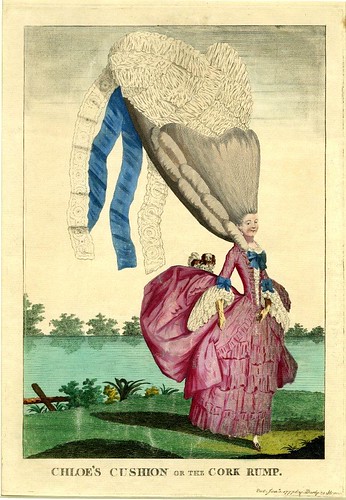
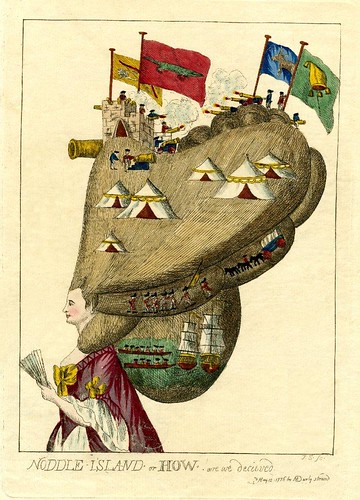

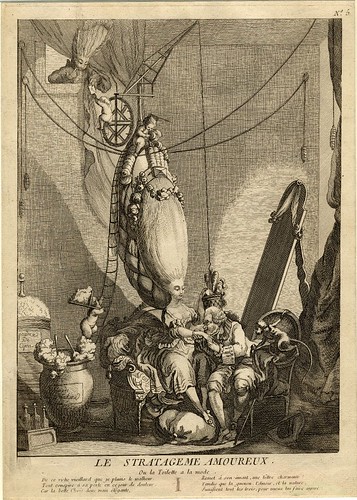

Noddle-Island or How are we Decieved 1776
Hand-coloured etching published by Matthew Darly in 1776 depicting a lady on whose grotesquely extended coiffure military operations are proceeding.
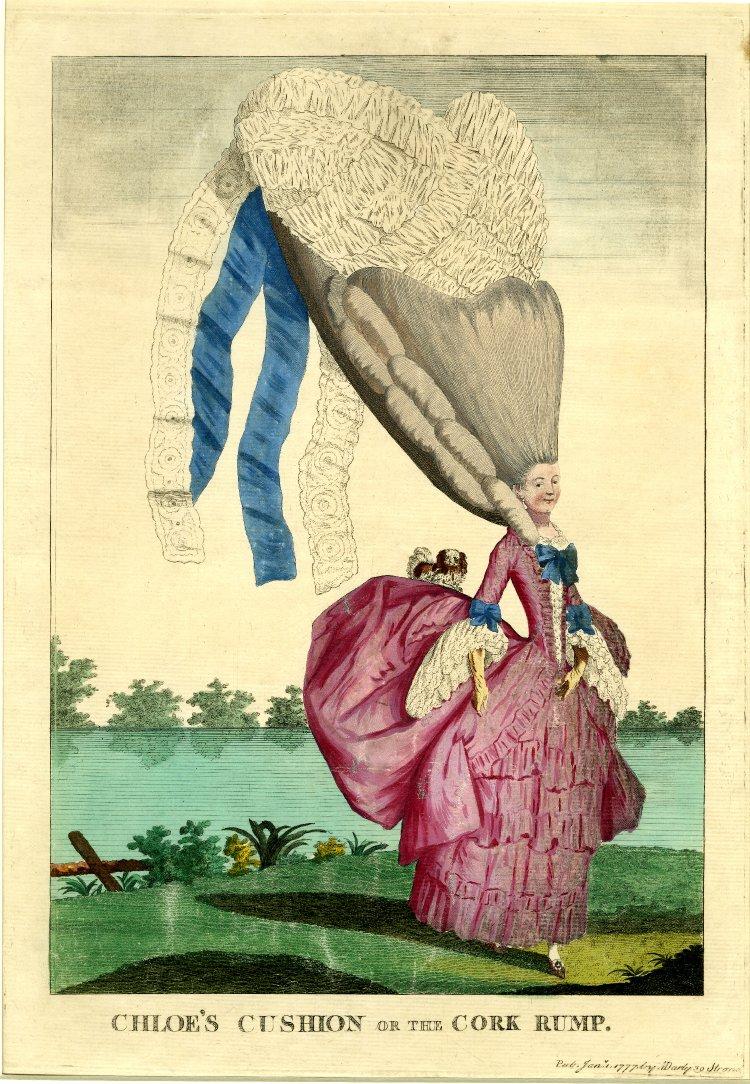
Chloe's Cushion, or, The Cork Rump 1777 (in colour)
Print made by M Darly in 1777
A lady out walking by a lake, dressed in a grotesque caricature of the prevailing fashion. Her petticoats project behind her in an ascending curve, on which lies a King Charles spaniel. Her hair is dressed in a mountainous inverted pyramid, the apex represented by her head; it is flanked by side-curls and surmounted by interlaced ribbons from which hang streamers of ribbon and lace.

La Françoise à Londres. The French Lady in London, or the Head Dress for the Year 1771
Anonymous print after Samuel H Grimm]
"After Hogarth and before the French Revolution the humour directed at the French in caricatures is gentler. The satire is usually focussed on fashion and hairstyles, the latter being the subject of this print. The fashion for wealthy French women of the 1760s and 1770s was to wear their powdered hair tall, although this lady's coiffure is monstrously exaggerated."

Bunkers Hill or America's head dress 1776

The Green Stall
1777 etching published by Matthew Darly. The head of a young woman in profile is the foundation of a monstrous inverted pyramid of hair decorated with vegetables; carrots predominating. On the top are heaped a large bundle of asparagus, a set of scales in one bowl of which are potatoes, a bunch of herbs (taking the place of the ostrich feathers of fashion), a cabbage, turnips, &c. Large carrots take the place of the large curls then worn flanking the coiffure; three bunches of carrots are the main decoration of the surface of the hair, on which are also a cabbage and clusters of leaves (or lettuces). Trails of pea-pods hang from the top of the head-dress after the manner of the lace lappets and ribbons then worn.
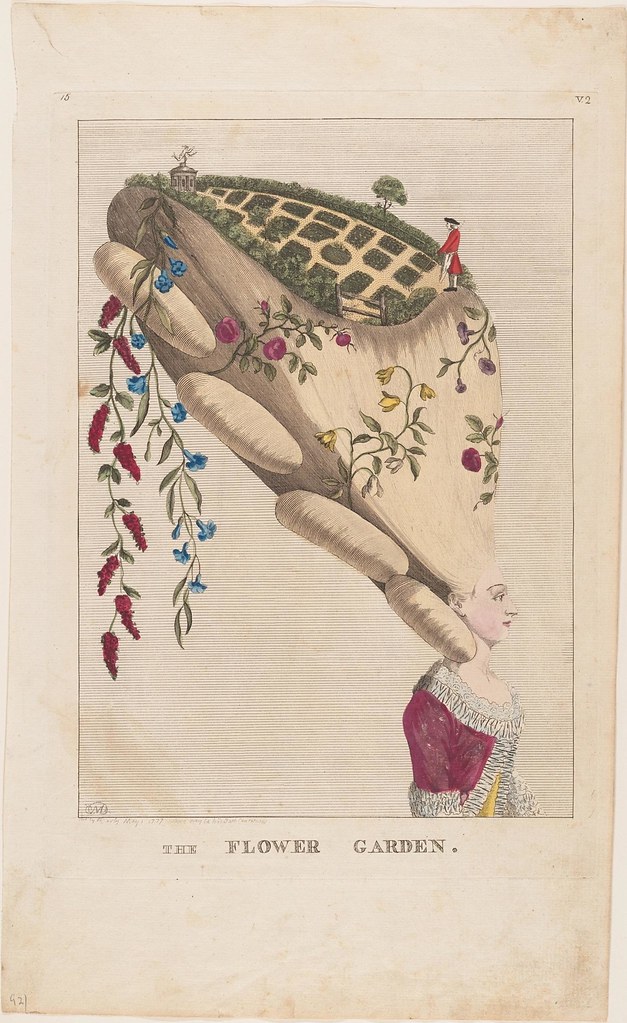
The Flower Garden
[B&W version]
Hand-coloured etched engraving published by M Darly in 1777.
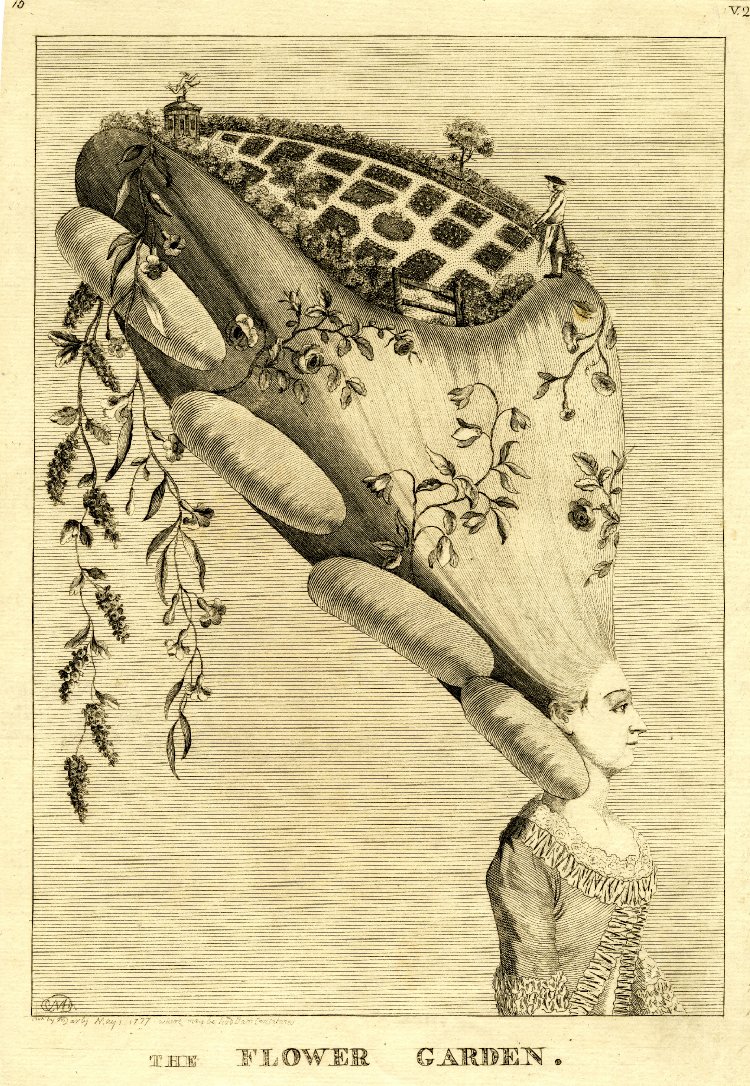
Fruit Stall
Etching published by Matthew Darly in London in 1777. The head of a woman in profile is the foundation of a monstrous inverted pyramid of hair, decorated with the wares of a fruiterer. On the top are a basket of peaches and a large pineapple with its leaves. Down the side of the pyramid, where curls were worn, are large gourds of different shapes. The hair is further ornamented by two tall pottles of strawberries, bunches of grapes, pears growing on branches, a basket of plums, a basket of raspberries, and other fruit.

This is Something New
[B&W version]
Published by J Lockington in 1777, this etching shows a lady with her hair in a gigantic pyramid, protected by an enormous umbrella on a very long stick. Her draped over-skirt projects at the back in mountainous folds (support known as the 'corks's rump'). On these is seated a foppishly dressed man taking shelter under the projection of her hair. A simple countryman, whose hat has fallen to the ground, gapes at the pair in amazement. A fashionably dressed man on the right leers and points at them.

Cupid's Tower
Fair tresses Man's imperial race ensnare,
And beauty draws us with a single hair
A lady in profile with an enormous pyramid of hair in the fashion of the day. On the broad summit of the pyramid lies a miniature cupid fitting an arrow to his bow and about to aim in the direction in which the lady is looking. She wears the fashionable 'full-dress' of the period.
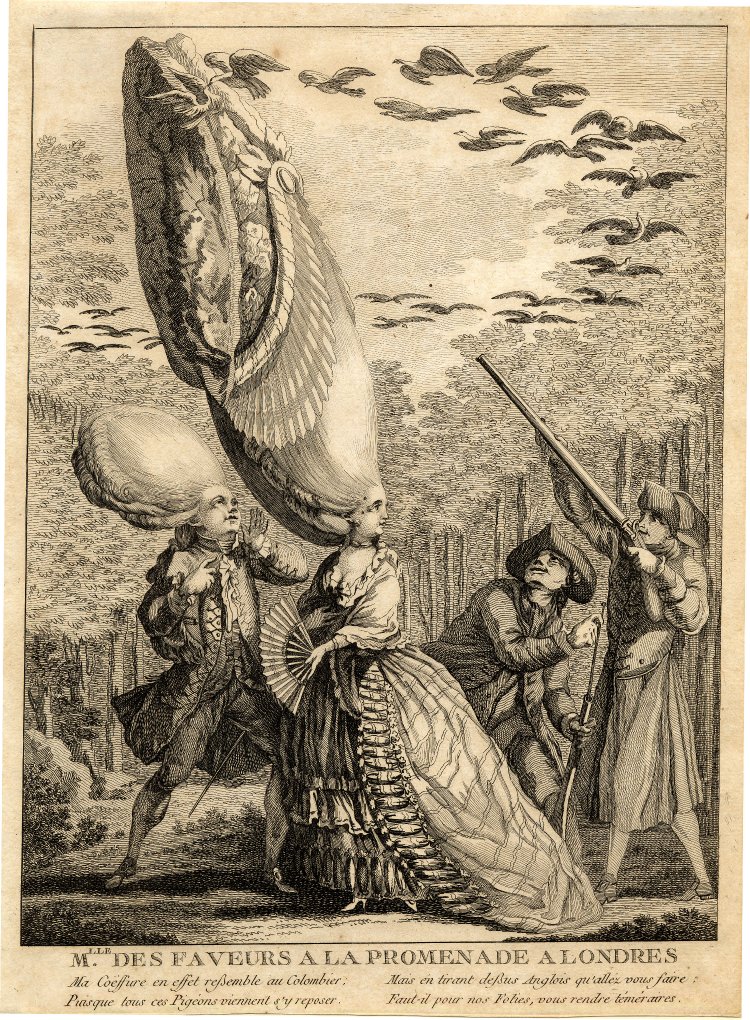
Mlle des Faveurs a la Promenade a Londres
Ma coiffure en effet ressemble au colombier,
Puisque tous ces pigeons viennent s'y reposer,
Mais en tirant dessus Anglois qu'allez vous faire,
Faut-il pour nos folies, vous rendre téméraires
Anonymous etching from about 1775. Satire on coiffures: A Frenchwoman with a ridiculously tall hair arrangement turns in amazement as an Englishman shoots at a flock of birds nesting in it.
---------------Belle Poule-------------------
Еще картинки с прической la Belle Poule".
Прическа "la Belle Poule"- в честь знаменитого фрегата,победившего англичан в морском сражении в войне США за независимость в 1778 году.
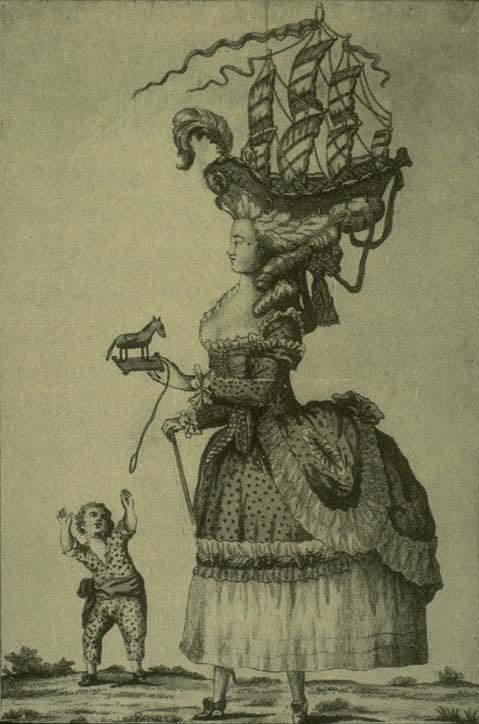
La coiffure à la Belle Poule

la Belle Poule
"The Belle Poule was a French frigate of the Dédaigneuse class, designed and built by Léon-Michel Guignace, famous for her duel with the English frigate HMS Arethusa on 17 June 1778, which began the French involvement in the American War of Independence."
"One of the most fashionable hairstyles of the eighteenth century, À la Belle Poule, commemorated the victory of a French ship over an English ship in 1778. À la Belle Poule featured an enormous pile of curled and powdered hair stretched over a frame affixed to the top of a woman's head. The hair was then decorated with an elegant model of the Belle Poule ship, including sails and flags."

One of the most fashionable hairstyles of the eighteenth century was called: À la Belle Poule, which commemorated the victory of a French ship over an English ship in 1778.
------------------
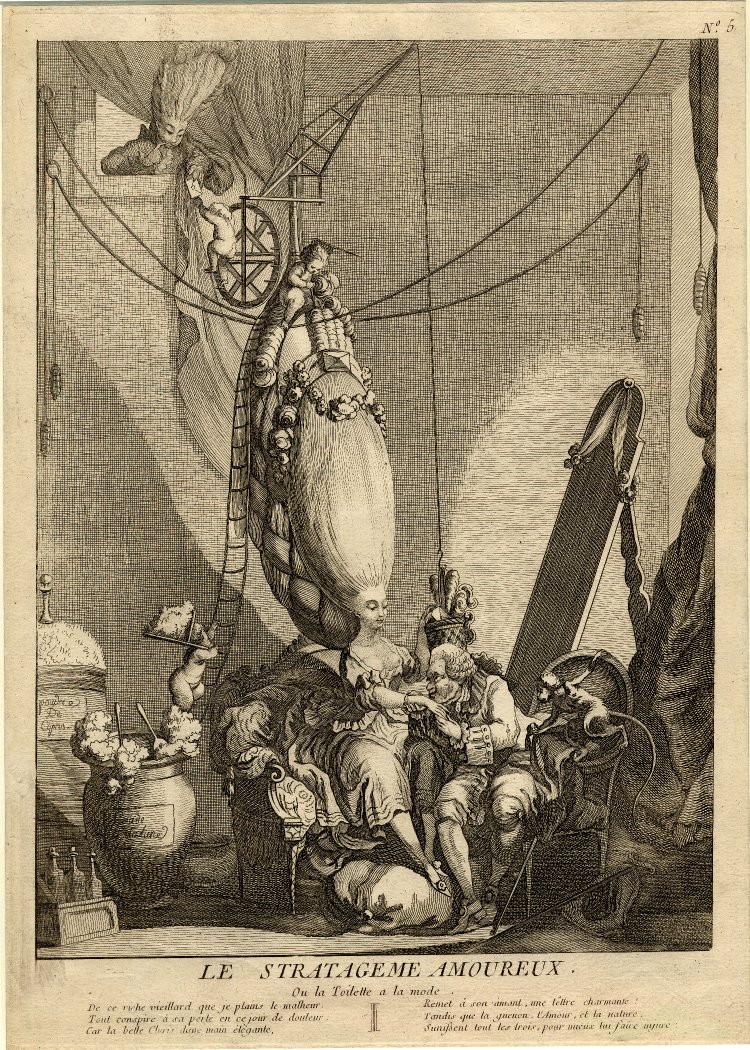
Le Stratageme Amoureux, ou la Toilette à la Mode
(The Lovers' Strategy or Fashionable Grooming)
Anonymous 1770s etching (one of a series, all apparently by the same hand). Satire on coiffures: A Frenchwoman is kissed by her elderly husband, while a procession of cupids climb a ladder along her ridiculously tall hair arrangement to deliver letters to her young lover above.

Ridiculous Taste or the Ladies Absurdity
[alternative version]
1776* mezzotint, published by Sayer & Bennett (after Darly), of a hairdresser mounting a ladder to get at the hair of a lady with an enormous coiffure, while another man holds a sextant to measure the distance. [*this might actually be the original print from 1771 and the alternative version was published later]

The Female Pyramid
Anonymous 1771 etching from The Oxford Magazine, showing a hairdresser on a ladder with shears trimming the woman's absurdly high coiffure while a man views the action through a telescope.

The Preposterous Head Dress, or, The Featherd Lady (sic)
Etched engraving published by M Darly in 1776
"Both the lady and her maid sport the inverted heart-shaped pyramid all the rage in 1776 and 1777. The Duchess of Devonshire was said to have begun the fashion for ostrich feathers, seen here decorating the headdress along with fruit and carrots. Late in her life Lady Louisa Stuart wrote about the opposition to ostrich feathers as part of a headdress: 'This fashion was not attacked as fantastic or unbecoming or inconvenient or expensive, but as seriously wrong or immoral. The unfortunate feathers were insulted mobbed burned almost pelted.' "

La Brillante Toillete de la Déesse du Gout
{The Brilliant Grooming or the Goddess of Taste}

Miss Juniper Fox
Hand-coloured etched engraving published by M Darly in 1777

The Extravaganza, or, The Mountain Head Dress of 1776

Rural Masquerade Dedicated to the Regatta'ites 1776
Published in London by J Lockington
"In the upper reaches of this headdress are figures dressed for a masquerade, promenading through a garden. Below is shown what may represent the first regatta in England, held 23 June 1775, partly on the Thames and partly at Ranelagh, where a temple of Neptune had been built. The bearer of this enormous coiffure, despite the female body, may be meant to be Neptune or Father Thames."

Lady All-Top
Published in London by J Lockington in 1776.
"Shown here is another magnificent heart-shaped pyramid of hair adorned with ostrich feathers, beads, and flowers, of the sort made fashionable by the Duchess of Devonshire in 1776. These hairstyles were labor-intensive and required cushions and wool, pomatum and powder, and an array of decorations. They were uncomfortable, they attracted insects and mice, and they could be fire hazards."

Oh Heigh Oh, or, A View of the Back Settlements
Published by M Darly in 1776. The print alludes to the region that is now Ohio which was then part of New France. Unlike the thirteen colonies on the eastern seaboard, New France was never effectively colonized and the population remained small. Since the main interest of the French was commercial exploitation (the basis of the economy was the fur trade), communities remained only frontier outposts.

Phaetona or Modern Female Taste
[jigsaw!]
Etched engraving published by M Darly in 1776.
"The lady and her hair dwarf the horses pulling her carriage, a phaeton. The Duchess of Devonshire may be the intended object of the satire here, given the ostrich feathers in the hair and the ducal coronet on the carriage."

The Ladies Contrivance or the Capital Conceit
Published by M Darly in 1777; artist: Miss Bath.
Juxtaposition of sedan chairs, one modified to accommodate the ridiculously exaggerated coiffure of its female occupant.

Boarding School Education, or the Frenchified Young Lady
Etching published by M Darly in 1771 with a young woman dancing to the violin played by her dancing master, while her proud mother sporting an enormous hairdo looks on. (note the poodle and monkey. The monkey, particularly, is a recurring satirical motif in many of these prints: preening? 'aping'? no smarter than apes?)
http://www.flickr.com/photos/bibliodyssey/sets/72157622421283654/

The Lady's Maid, or Toilet Head-Dress
Anonymous 1776 etching of a young woman with her hair in a much exaggerated inverted pyramid which fills the greater part of the design and is the support for a dressing-table, draped with muslin festoons. On it are an oval mirror, a pair of tapers in candlesticks, two vases of flowers, a pin-cushion, toilet articles, a pair of buckles, rings, a necklace, &c, two books, a pen.

Long Corks or the Bottle Companions
Published by M Darly in 1777
Two extravagantly dressed women face each other, each seated on, or rather supported by, an enormous cork which projects from the neck of a bottle. Both are elderly, one (left) enormously fat, the other very thin. Both wear the grotesque pyramids of hair, flanked by ringlets like large sausages and surmounted by ostrich-feathers, so much caricatured since 1776

Proportion
Published in 1777 by J Lockington, this half-man half-woman print contrasts the gender styles of the time, exaggerating the female fashion and hairdo, while the male's appearance is more natural by comparison.

Miss Prattle, Consulting Doctor Double Fee about her Pantheon Head Dress
Hand-coloured mezzotint published by Carington Bowles in 1771. The counsellor and his client sit facing one another across a table, beneath which their knees touch. The lady wears a grotesquely high pyramid of hair, decorated with pearls or beads and a high lace cap with ribbons and lace lappets. She looks intently at the Counsellor who is wearing a legal tie-wig, gown, and bands. On the wall is a framed picture of two monkeys sitting on each side of a round table, each with a tea-cup.

Leaving off Powder, or A Frugal Family Saving the Guinea
Hand-coloured print by James Gillray, published by Hannah Humphrey in 1795: a satirical response to the tax on hair powder; including a portrait of Charles II with a huge powdered wig.

Beauty's Lot, English, 1778
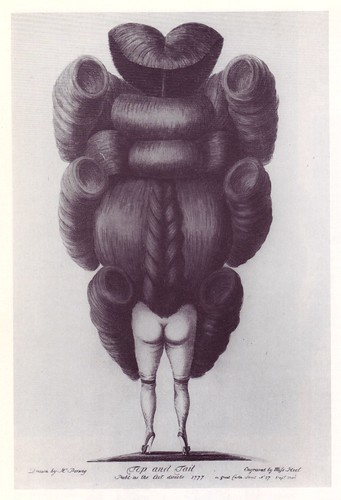
Top and Tail (1777)

The Donry or Top and Tail Turn'd About
"Embellished with the French Favourite Circle called a la Zodiaque just imported. see Lady's Magazine N. XC. Humbly dedicated to the fine Ladies of the petty gentry by Monsieur Periwig from Paris." {Engravings by Miss Heel in 1777}
------------------Еще несколько причесок Марии-Антуанетты------------------------

Marie Antoinette by Jacques-Fabien Gautier D'Agoty (1775) Musee Antoine-Lecuyer, Saint-Quentin France
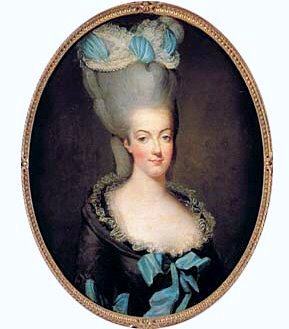




Лопаточки для чесания головы
"Fashionable" hairstyles for women began their vertical climb in the late 1760s, and with them rose the ire of social critics. Editorials appearing in London periodicals immediately decried the large headdresses that English ladies were all too eager to copy from their French counterparts.
Chronicling the rise and fall of the fashion takes us from the courts of France to the printshops of London and finally to the streets of Philadelphia in 1778, where all that the high roll represented in a new nation at war with an old empire was brought quite literally to a head."1

А вот так делают такие прически- сначала прикрепляется болван, потом закрывается со всех сторон своими волосами. Вот что удалось найти:

Сначала ставился каркас из проволоки
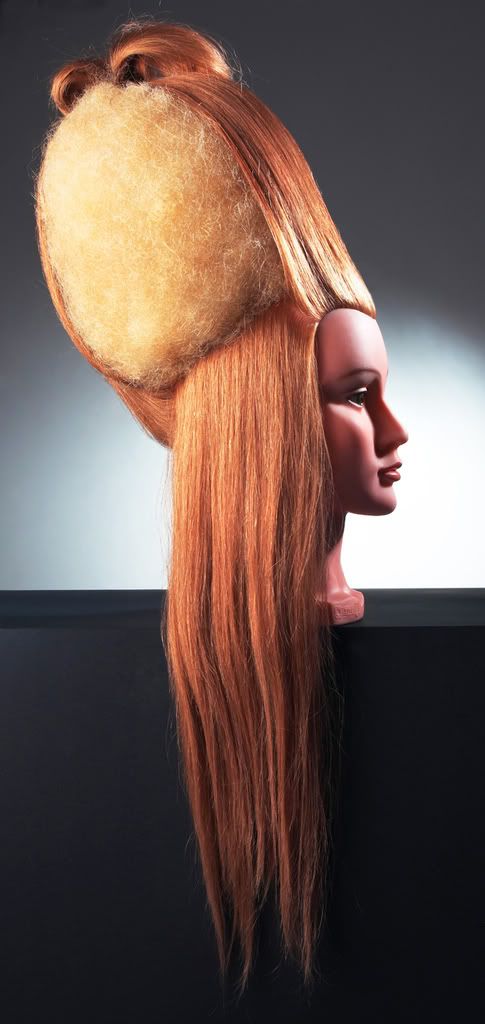
Потом на него зачесывались волосы или шиньоны


Оставшаяся часть волос снизу закручивалась
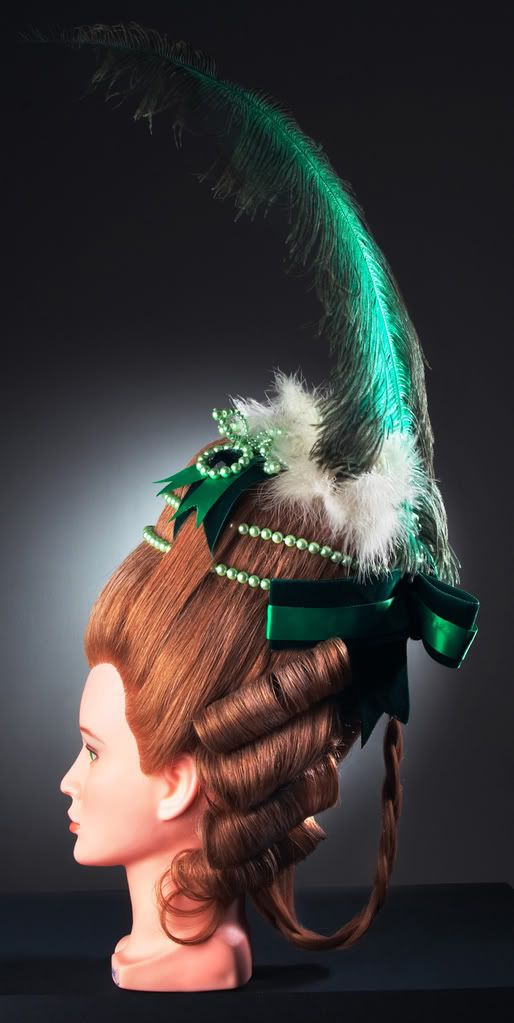
Прическа украшалась перьями и разного рода украшениями.

В Институте Современного Искусства Валенсии (IVAM - Instituto Valenciano de Arte Moderno) открылась необычная выставка парикмахера и стилиста Тоно Санмартина (Tono Sanmartin), создавшего четырнадцать «скульптур из волос» с головными украшениями в стиле XVIII века, где особо выделяляется разноцветное рококо причесок и локонов.
Произведения Санмартина выполнены на манекенах и их основой стали четырнадцать гравюр XVIII века миланского Фонда Антонио Маццота, которые также можно увидеть в том же зале IVAM.
Парикмахер, получивший "Grand Trophy of the Proffesional Press 2006" (премия, которой награждают по признанию прессы лучшего в мире парикмахера), одел манекены в черные корсеты из различных тканей выполненные дизайнером Ампаро Хорда.

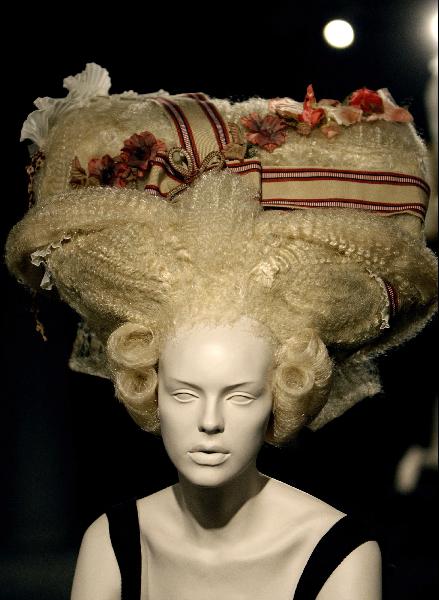
На головах манекенов видны сложные декоративные элементы, от украшений из шелка или цветных перьев до макетов кораблей, выполненные на фабриках и в мастерских Валенсийского Сообщества.
Экспозиция «Тоно Санмартин. В манере XVIII века» была презентована 23 октября на прессконференции советником Культуры и Спорта Тринидад Миро.
Она считает, что в работах Санмартина объединяются его мастерство как стилиста и скульптора, «как это делали в свое время Коко Шанель, Баленсиага и Кристиан Диор».
По этой причине «его работы выставлены в многочисленных картинных галереях всего мира и теперь представлены публике IVAMа, музее, который представляет экспозиции ломающие все традиции такие, какой является эта», отметила Тринидад Миро.

Для этих четырнадцати произведений было использовано 98 флакончиков лака, но самым сложным, по его признанию, было работать с манекенами, «немыми и неподвижными женщинами».
Начало:Женские прически конца 18 века и карикатуры на них-ТУТ
Thanks to:
http://bibliodyssey.blogspot.com/2009/09/waiter-theres-hair-in-my-satire.html
http://soodiebeasley.blogspot.com/2009/08/marie-antoinette-big-hair-and-moi-part.html
http://elize-sun.livejournal.com/132362.html
http://www.liveinternet.ru/users/arin_levindor/post60391045/
Удалось найти еще карикатуры, некоторые у меня были в предыдущем посте, но сейчас нашлись большие, в хорошем качестве и с подробным описанием. Многие прически существовали в действительности- пейзажи, фермы, сады , горы и так далее. Портретов не сохранилось, но карикатуры пусть утрированно, но позволяют увидеть эти произведения парикмахерского искусства.
Также нашлось немного фотографий, где показан процесс создания таких причесок.





Noddle-Island or How are we Decieved 1776
Hand-coloured etching published by Matthew Darly in 1776 depicting a lady on whose grotesquely extended coiffure military operations are proceeding.

Chloe's Cushion, or, The Cork Rump 1777 (in colour)
Print made by M Darly in 1777
A lady out walking by a lake, dressed in a grotesque caricature of the prevailing fashion. Her petticoats project behind her in an ascending curve, on which lies a King Charles spaniel. Her hair is dressed in a mountainous inverted pyramid, the apex represented by her head; it is flanked by side-curls and surmounted by interlaced ribbons from which hang streamers of ribbon and lace.

La Françoise à Londres. The French Lady in London, or the Head Dress for the Year 1771
Anonymous print after Samuel H Grimm]
"After Hogarth and before the French Revolution the humour directed at the French in caricatures is gentler. The satire is usually focussed on fashion and hairstyles, the latter being the subject of this print. The fashion for wealthy French women of the 1760s and 1770s was to wear their powdered hair tall, although this lady's coiffure is monstrously exaggerated."

Bunkers Hill or America's head dress 1776

The Green Stall
1777 etching published by Matthew Darly. The head of a young woman in profile is the foundation of a monstrous inverted pyramid of hair decorated with vegetables; carrots predominating. On the top are heaped a large bundle of asparagus, a set of scales in one bowl of which are potatoes, a bunch of herbs (taking the place of the ostrich feathers of fashion), a cabbage, turnips, &c. Large carrots take the place of the large curls then worn flanking the coiffure; three bunches of carrots are the main decoration of the surface of the hair, on which are also a cabbage and clusters of leaves (or lettuces). Trails of pea-pods hang from the top of the head-dress after the manner of the lace lappets and ribbons then worn.

The Flower Garden
[B&W version]
Hand-coloured etched engraving published by M Darly in 1777.

Fruit Stall
Etching published by Matthew Darly in London in 1777. The head of a woman in profile is the foundation of a monstrous inverted pyramid of hair, decorated with the wares of a fruiterer. On the top are a basket of peaches and a large pineapple with its leaves. Down the side of the pyramid, where curls were worn, are large gourds of different shapes. The hair is further ornamented by two tall pottles of strawberries, bunches of grapes, pears growing on branches, a basket of plums, a basket of raspberries, and other fruit.

This is Something New
[B&W version]
Published by J Lockington in 1777, this etching shows a lady with her hair in a gigantic pyramid, protected by an enormous umbrella on a very long stick. Her draped over-skirt projects at the back in mountainous folds (support known as the 'corks's rump'). On these is seated a foppishly dressed man taking shelter under the projection of her hair. A simple countryman, whose hat has fallen to the ground, gapes at the pair in amazement. A fashionably dressed man on the right leers and points at them.

Cupid's Tower
Fair tresses Man's imperial race ensnare,
And beauty draws us with a single hair
A lady in profile with an enormous pyramid of hair in the fashion of the day. On the broad summit of the pyramid lies a miniature cupid fitting an arrow to his bow and about to aim in the direction in which the lady is looking. She wears the fashionable 'full-dress' of the period.

Mlle des Faveurs a la Promenade a Londres
Ma coiffure en effet ressemble au colombier,
Puisque tous ces pigeons viennent s'y reposer,
Mais en tirant dessus Anglois qu'allez vous faire,
Faut-il pour nos folies, vous rendre téméraires
Anonymous etching from about 1775. Satire on coiffures: A Frenchwoman with a ridiculously tall hair arrangement turns in amazement as an Englishman shoots at a flock of birds nesting in it.
---------------Belle Poule-------------------
Еще картинки с прической la Belle Poule".
Прическа "la Belle Poule"- в честь знаменитого фрегата,победившего англичан в морском сражении в войне США за независимость в 1778 году.

La coiffure à la Belle Poule

la Belle Poule
"The Belle Poule was a French frigate of the Dédaigneuse class, designed and built by Léon-Michel Guignace, famous for her duel with the English frigate HMS Arethusa on 17 June 1778, which began the French involvement in the American War of Independence."
"One of the most fashionable hairstyles of the eighteenth century, À la Belle Poule, commemorated the victory of a French ship over an English ship in 1778. À la Belle Poule featured an enormous pile of curled and powdered hair stretched over a frame affixed to the top of a woman's head. The hair was then decorated with an elegant model of the Belle Poule ship, including sails and flags."

One of the most fashionable hairstyles of the eighteenth century was called: À la Belle Poule, which commemorated the victory of a French ship over an English ship in 1778.
------------------

Le Stratageme Amoureux, ou la Toilette à la Mode
(The Lovers' Strategy or Fashionable Grooming)
Anonymous 1770s etching (one of a series, all apparently by the same hand). Satire on coiffures: A Frenchwoman is kissed by her elderly husband, while a procession of cupids climb a ladder along her ridiculously tall hair arrangement to deliver letters to her young lover above.

Ridiculous Taste or the Ladies Absurdity
[alternative version]
1776* mezzotint, published by Sayer & Bennett (after Darly), of a hairdresser mounting a ladder to get at the hair of a lady with an enormous coiffure, while another man holds a sextant to measure the distance. [*this might actually be the original print from 1771 and the alternative version was published later]

The Female Pyramid
Anonymous 1771 etching from The Oxford Magazine, showing a hairdresser on a ladder with shears trimming the woman's absurdly high coiffure while a man views the action through a telescope.

The Preposterous Head Dress, or, The Featherd Lady (sic)
Etched engraving published by M Darly in 1776
"Both the lady and her maid sport the inverted heart-shaped pyramid all the rage in 1776 and 1777. The Duchess of Devonshire was said to have begun the fashion for ostrich feathers, seen here decorating the headdress along with fruit and carrots. Late in her life Lady Louisa Stuart wrote about the opposition to ostrich feathers as part of a headdress: 'This fashion was not attacked as fantastic or unbecoming or inconvenient or expensive, but as seriously wrong or immoral. The unfortunate feathers were insulted mobbed burned almost pelted.' "

La Brillante Toillete de la Déesse du Gout
{The Brilliant Grooming or the Goddess of Taste}

Miss Juniper Fox
Hand-coloured etched engraving published by M Darly in 1777

The Extravaganza, or, The Mountain Head Dress of 1776

Rural Masquerade Dedicated to the Regatta'ites 1776
Published in London by J Lockington
"In the upper reaches of this headdress are figures dressed for a masquerade, promenading through a garden. Below is shown what may represent the first regatta in England, held 23 June 1775, partly on the Thames and partly at Ranelagh, where a temple of Neptune had been built. The bearer of this enormous coiffure, despite the female body, may be meant to be Neptune or Father Thames."

Lady All-Top
Published in London by J Lockington in 1776.
"Shown here is another magnificent heart-shaped pyramid of hair adorned with ostrich feathers, beads, and flowers, of the sort made fashionable by the Duchess of Devonshire in 1776. These hairstyles were labor-intensive and required cushions and wool, pomatum and powder, and an array of decorations. They were uncomfortable, they attracted insects and mice, and they could be fire hazards."

Oh Heigh Oh, or, A View of the Back Settlements
Published by M Darly in 1776. The print alludes to the region that is now Ohio which was then part of New France. Unlike the thirteen colonies on the eastern seaboard, New France was never effectively colonized and the population remained small. Since the main interest of the French was commercial exploitation (the basis of the economy was the fur trade), communities remained only frontier outposts.

Phaetona or Modern Female Taste
[jigsaw!]
Etched engraving published by M Darly in 1776.
"The lady and her hair dwarf the horses pulling her carriage, a phaeton. The Duchess of Devonshire may be the intended object of the satire here, given the ostrich feathers in the hair and the ducal coronet on the carriage."

The Ladies Contrivance or the Capital Conceit
Published by M Darly in 1777; artist: Miss Bath.
Juxtaposition of sedan chairs, one modified to accommodate the ridiculously exaggerated coiffure of its female occupant.

Boarding School Education, or the Frenchified Young Lady
Etching published by M Darly in 1771 with a young woman dancing to the violin played by her dancing master, while her proud mother sporting an enormous hairdo looks on. (note the poodle and monkey. The monkey, particularly, is a recurring satirical motif in many of these prints: preening? 'aping'? no smarter than apes?)
http://www.flickr.com/photos/bibliodyssey/sets/72157622421283654/

The Lady's Maid, or Toilet Head-Dress
Anonymous 1776 etching of a young woman with her hair in a much exaggerated inverted pyramid which fills the greater part of the design and is the support for a dressing-table, draped with muslin festoons. On it are an oval mirror, a pair of tapers in candlesticks, two vases of flowers, a pin-cushion, toilet articles, a pair of buckles, rings, a necklace, &c, two books, a pen.

Long Corks or the Bottle Companions
Published by M Darly in 1777
Two extravagantly dressed women face each other, each seated on, or rather supported by, an enormous cork which projects from the neck of a bottle. Both are elderly, one (left) enormously fat, the other very thin. Both wear the grotesque pyramids of hair, flanked by ringlets like large sausages and surmounted by ostrich-feathers, so much caricatured since 1776

Proportion
Published in 1777 by J Lockington, this half-man half-woman print contrasts the gender styles of the time, exaggerating the female fashion and hairdo, while the male's appearance is more natural by comparison.

Miss Prattle, Consulting Doctor Double Fee about her Pantheon Head Dress
Hand-coloured mezzotint published by Carington Bowles in 1771. The counsellor and his client sit facing one another across a table, beneath which their knees touch. The lady wears a grotesquely high pyramid of hair, decorated with pearls or beads and a high lace cap with ribbons and lace lappets. She looks intently at the Counsellor who is wearing a legal tie-wig, gown, and bands. On the wall is a framed picture of two monkeys sitting on each side of a round table, each with a tea-cup.

Leaving off Powder, or A Frugal Family Saving the Guinea
Hand-coloured print by James Gillray, published by Hannah Humphrey in 1795: a satirical response to the tax on hair powder; including a portrait of Charles II with a huge powdered wig.

Beauty's Lot, English, 1778

Top and Tail (1777)

The Donry or Top and Tail Turn'd About
"Embellished with the French Favourite Circle called a la Zodiaque just imported. see Lady's Magazine N. XC. Humbly dedicated to the fine Ladies of the petty gentry by Monsieur Periwig from Paris." {Engravings by Miss Heel in 1777}
------------------Еще несколько причесок Марии-Антуанетты------------------------

Marie Antoinette by Jacques-Fabien Gautier D'Agoty (1775) Musee Antoine-Lecuyer, Saint-Quentin France





Лопаточки для чесания головы
"Fashionable" hairstyles for women began their vertical climb in the late 1760s, and with them rose the ire of social critics. Editorials appearing in London periodicals immediately decried the large headdresses that English ladies were all too eager to copy from their French counterparts.
Chronicling the rise and fall of the fashion takes us from the courts of France to the printshops of London and finally to the streets of Philadelphia in 1778, where all that the high roll represented in a new nation at war with an old empire was brought quite literally to a head."1

А вот так делают такие прически- сначала прикрепляется болван, потом закрывается со всех сторон своими волосами. Вот что удалось найти:

Сначала ставился каркас из проволоки

Потом на него зачесывались волосы или шиньоны


Оставшаяся часть волос снизу закручивалась

Прическа украшалась перьями и разного рода украшениями.

В Институте Современного Искусства Валенсии (IVAM - Instituto Valenciano de Arte Moderno) открылась необычная выставка парикмахера и стилиста Тоно Санмартина (Tono Sanmartin), создавшего четырнадцать «скульптур из волос» с головными украшениями в стиле XVIII века, где особо выделяляется разноцветное рококо причесок и локонов.
Произведения Санмартина выполнены на манекенах и их основой стали четырнадцать гравюр XVIII века миланского Фонда Антонио Маццота, которые также можно увидеть в том же зале IVAM.
Парикмахер, получивший "Grand Trophy of the Proffesional Press 2006" (премия, которой награждают по признанию прессы лучшего в мире парикмахера), одел манекены в черные корсеты из различных тканей выполненные дизайнером Ампаро Хорда.


На головах манекенов видны сложные декоративные элементы, от украшений из шелка или цветных перьев до макетов кораблей, выполненные на фабриках и в мастерских Валенсийского Сообщества.
Экспозиция «Тоно Санмартин. В манере XVIII века» была презентована 23 октября на прессконференции советником Культуры и Спорта Тринидад Миро.
Она считает, что в работах Санмартина объединяются его мастерство как стилиста и скульптора, «как это делали в свое время Коко Шанель, Баленсиага и Кристиан Диор».
По этой причине «его работы выставлены в многочисленных картинных галереях всего мира и теперь представлены публике IVAMа, музее, который представляет экспозиции ломающие все традиции такие, какой является эта», отметила Тринидад Миро.

Для этих четырнадцати произведений было использовано 98 флакончиков лака, но самым сложным, по его признанию, было работать с манекенами, «немыми и неподвижными женщинами».
Начало:Женские прически конца 18 века и карикатуры на них-ТУТ
Thanks to:
http://bibliodyssey.blogspot.com/2009/09/waiter-theres-hair-in-my-satire.html
http://soodiebeasley.blogspot.com/2009/08/marie-antoinette-big-hair-and-moi-part.html
http://elize-sun.livejournal.com/132362.html
http://www.liveinternet.ru/users/arin_levindor/post60391045/